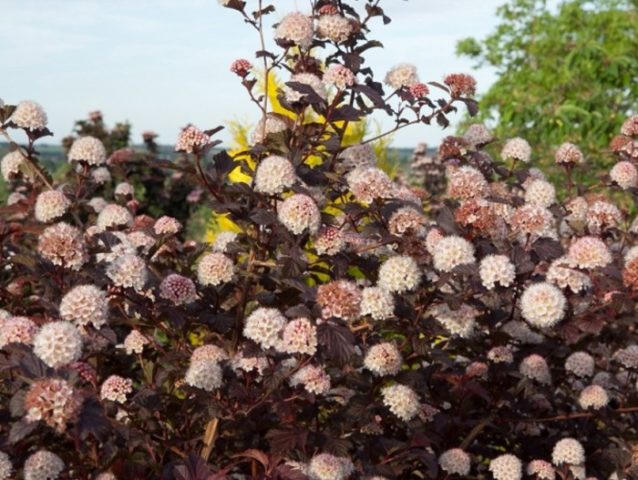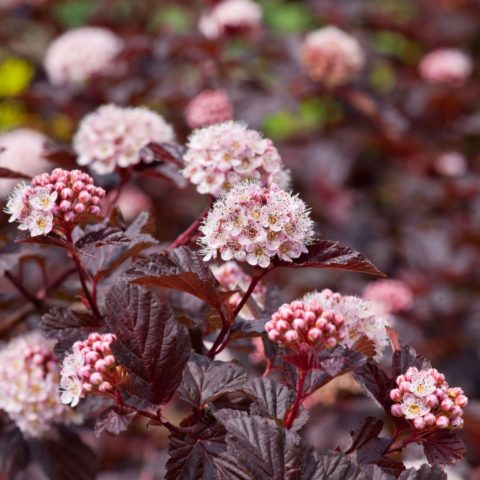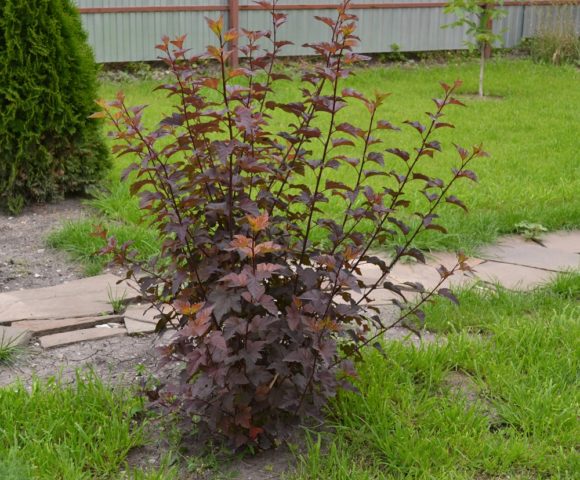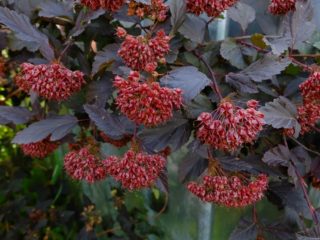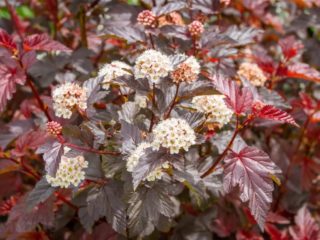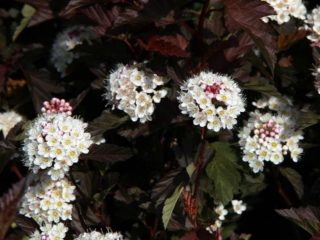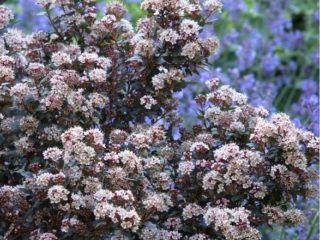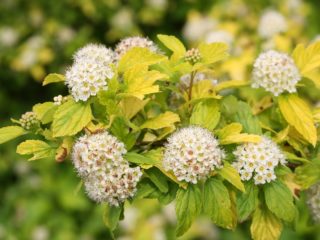Content
To decorate their garden plots, gardeners often plant ornamental and exotic shrubs. Thanks to its bright foliage and ease of care, the Lady in Red vesicle carp occupies a leading place. To grow it, you need to know the intricacies of planting and care, propagation and pruning.
Description of Lady in Red
Lady in Red is a new variety bred in 2012 by English breeders. Thanks to its unpretentiousness and bright foliage, the shrub immediately gained popularity among gardeners. The plant translated from English means “lady in red.” The bush received this name for its red foliage and decorative appearance.
Brief description of Lady in Red:
- The bush is small, grows up to 1-1.5 m. Width and density depend on the type of pruning chosen.
- The wrinkled, red-brown leaf consists of 3-5 oval-shaped lobes, up to 1.2 m in diameter.
- In June, the shrub is covered with small, pink flowers, collected in hemispherical inflorescences up to 5 cm in size.
- At the beginning of autumn, after flowering, the bush is covered with red-brown fruits, which do not fall off when ripe, but hang on the branch all winter.
- Red Lady is a sun-loving shrub; when planted in a sunny place, the foliage acquires a bright burgundy color; when grown in the shade, the foliage loses its decorative appearance.
- The plant is unpretentious and frost-resistant.
To see all the beauty of Lady in Red, you can view the photo:
Lady in Red in landscape design
Due to its decorative properties, Red Lady's vesicle is used to decorate a summer cottage. It is planted next to the main entrance, near gazebos and in the recreation area. Bright foliage goes well with conifers and ornamental shrubs. Due to the dense foliage, timely pruning of the bush results in a beautiful hedge.
Red Lady's bladderwort grows in any climate and in any soil. Also, Lady in Red is not afraid of polluted air and does not lose its decorative effect in places with poor ecology. Thanks to these characteristics, bushes are planted in city squares and parks, and they look great as borders along roads.
Conditions for growing bladderwort Lady in Red
Red Lady's bladderwort is an unpretentious shrub. To make it decorative, place the plant in a sunny place in nutritious, well-drained soil. In order for the shrub to have a wide crown and bloom profusely, it is grown on loamy soil with neutral acidity.
When choosing a place for planting, you need to take into account that Red Lady has a shallow root system, so proximity to large and fruit trees is undesirable. Since tall trees have powerful roots that will begin to suck out moisture, nutrients from the soil will be to the detriment of the bush.
Planting and caring for Lady in Red
When purchasing Red Lady bladderwort in a container, the young seedling is planted throughout the warm season. The bare-rooted plant is planted in spring or fall. Many gardeners prefer spring planting, since before the onset of frost, the bladderwort will have time to strengthen, take root and prepare for winter.
Decorative appearance and flowering depend on a healthy, strong seedling. Therefore, it is recommended to purchase it from trusted suppliers or from a nursery. The purchased plant must have strong, healthy roots and shoots without signs of disease or mechanical damage.
Preparing the landing site
To plant Red Lady bladderwrack, choose a sunny place without drafts or gusty winds. The soil must be fertile and well drained. When preparing the planting hole, the soil is dug up, peat, sand and rotted compost are added in equal proportions. If acidity is high, it can be adjusted with dolomite flour or wood ash. The prepared substrate is poured into a hole measuring 50x50 and left for 14 days.
Landing rules
In order for the plant to please with its decorative appearance and beautiful flowering, it is necessary to follow the rules of planting and care. Planting Red Lady bladderwort:
- The nutrient substrate is removed from the planting hole, leaving the hole size 50x50x50 cm.
- The seedling is spilled generously and carefully removed from the container.
- With a lump of earth, the plant is immersed in the hole so that the root collar is not buried, but is at ground level.
- The young bush is covered with fertile soil, compacting each layer so that there is no air space left.
- The planted bladderwort is watered abundantly, the soil is mulched with peat, straw or humus.
Watering and fertilizing
Since the roots of the Red Lady vesicle do not go deep into the ground, but are located superficially, it is necessary to carry out regular irrigation and timely fertilizing. The shrub needs increased irrigation in hot, dry summers and when grown on loamy soil. To do this, up to 30 liters of water are spilled under each adult bush 2 times a week. In other cases, irrigation is carried out as the top layer of soil dries out.
After watering, the soil is mulched with straw, dry leaves or rotted compost. Mulch will retain moisture, make the soil loose and breathable, and also saturate the soil with micronutrients.
Plant nutrition is necessary for good growth, flowering and frost resistance:
- In the spring, before the sap flows and the buds open, 0.5 liters of mullein or bird droppings and 1 liter of nettle, green infusion are diluted in a bucket of water. You can also use any nitrogenous fertilizer.
- In the fall, before the onset of cold weather, the shrub needs phosphorus and potassium; wood ash is suitable as a top dressing.
10 liters of nutritious infusion are poured under each plant.
Trimming
If timely pruning is not carried out, the Lady in Red vesicle will lose its decorative appearance, and diseases and pests may join it. Growth and flowering also depend on proper pruning, so it must be carried out according to certain rules:
- Sanitary – remove broken, damaged, weakened and unwintered shoots. The procedure is carried out in the spring or as needed.
- Formative – after flowering, the branches are cut to 1/3 of their length.
- To form a hedge, pruning is carried out to the required height in mid or late summer.
- Rejuvenating - all the shoots under the stump are cut out from the old bush, giving the opportunity for young shoots to appear.
Preparing for winter
The frost-resistant Red Lady vesicle does not need shelter. But young seedlings, when grown in regions with an unstable climate, should be hidden under non-woven covering material. In a snowy winter, a frame is installed above the bush and covered with a snowdrift. It will retain heat, moisture and protect the seedling from frost.
Reproduction of Lady in Red
The viburnum physocarpus Lady in Red can be propagated by cuttings, branching and dividing the bush.
Cuttings - an effective method of reproduction. To do this, planting material 10-15 cm long is cut from annual shoots. The lower leaves are removed, the upper ones are shortened by ½ length. The prepared cuttings are dipped into a root formation stimulator for 20 minutes and placed at an angle in a container with moist, nutritious soil.To maintain the required humidity, a microgreenhouse is installed above the cuttings. After the first buds appear, the shelter is removed and the container is placed in a bright, warm place. After a year, the strengthened seedling can be planted in a sunny area.
Dividing the bush - The easiest way. In spring or autumn, the bush is removed from the ground, trying not to cause mechanical damage to the root system. It is divided into the required number of divisions. Each part must have strong roots and healthy shoots. To prevent the root system from drying out, young bushes are immediately planted in a permanent place.
Bends – Reproduction is carried out in early spring. To do this, choose a strong, lower shoot. Dig a trench 10 cm deep and lay the branch, leaving the green top above the ground. The trench is covered with nutrient soil, watered and mulched. In the fall, the rooted branch is separated from the mother bush and planted in a permanent place. When cold weather sets in, the young plant is covered with agrofibre or non-woven material.
Diseases and pests
Lady in Red has strong immunity to diseases and insect pests. But if the bush does not have enough nutrients, it may suffer from chlorosis. When yellow foliage appears and the apical shoots dry out, it is necessary to begin treatment immediately. If no help is provided, the vesicle begins to wither, the leaves curl, dry out and fall off. To get rid of the disease, the bush is treated with iron-containing preparations.
Also, Red Lady's bladderwort can suffer from powdery mildew with abundant watering and high air humidity. The foliage becomes covered with a white coating, which can be easily removed with a finger.The disease can be eliminated with broad-spectrum fungicides.
Conclusion
Lady in Red is a worthy ornamental shrub that will decorate any garden plot. By following simple rules of care, you can ensure that the plant will show its original, striking beauty for many years.
